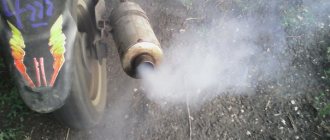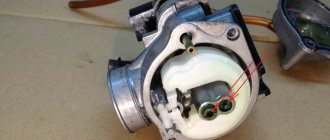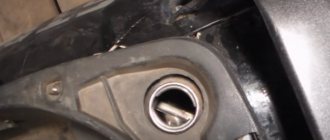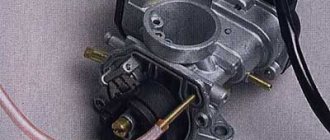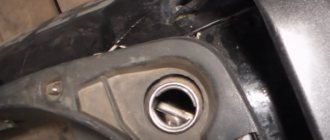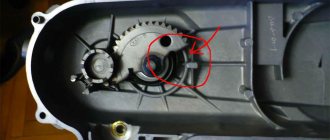Have you often seen smoke coming from the exhaust pipe of your scooter? Smoke from the exhaust pipe can be white, black, and other shades. At the same time, color serves as an important diagnostic sign and sometimes directly indicates malfunctions that have arisen in the engine. Before you panic, first tell, find out or remember what kind of engine you have in order to determine whether this is normal in principle, or whether there is some kind of breakdown behind the smoke.
Why does a 4t scooter (four-stroke) smoke?
Here things are already a little different.
The nature of a four-stroke engine is determined by the lubrication of parts in a separate oil bath, which is in no way connected with the combustion chamber. The obstacle, in this case, is the oil scraper rings, which actually prevent the oil from burning along with gasoline. The cause of smoking in a four-stroke engine is most often the presence of oil scraper rings in the piston groove or its wear. Now it does not remove oil from the cylinder walls during operation, and with each power stroke, part of the lubricant burns at top dead center. Naturally, this is a breakdown that needs to be fixed. Sometimes, many people confuse steam from the exhaust pipe with smoke. Water in the form of steam is a sign of high humidity in the exhaust system. In an unheated exhaust system, moisture from the air partially condenses and becomes visible, and water usually appears at the cut of the exhaust pipe. And as the system warms up, condensation and steam disappear. This is a common occurrence.
Source
Diagnostics
Let's determine which of the faults is present in your case. Much can be determined by the color of the smoke. For example, if the smoke is black, then the reason lies in a rich air-fuel mixture. A possible cause is an incorrect ignition angle. If the fuel mixture does not burn completely, its residues end up in the exhaust during the next engine stroke.
The blue color of the smoke characterizes the entry of engine oil into the combustion chamber. The reason for this may be worn or stuck oil scraper rings. Also, complete wear of the piston group entails increased smoke emissions and reduced thrust. Valves or valve seals that are in poor condition also produce unnatural smoke from the exhaust pipe.
For liquid-cooled engines with characteristic white smoke from the chimney, the cause is a blown cylinder head gasket . Coolant passes through the gasket rupture and enters the combustion chamber or exhaust.
The starter screams, the cord comes out
- May scream if there is a lot of lube on the balls. It is necessary to clean the balls and the places in the ratchet where they are inserted.
The cultivator released several pops and began to “float”
- Most likely, the power system is not coping, or the fuel level in the tank is low, the float axis may be skewed and perhaps there is debris under the needle valve, you need to remove everything and check the air filter, jets.
The material will be updated, we will be waiting for questions, stories about the detection of a particular malfunction and ways to eliminate it. Also see Answers to questions about a particular walk-behind tractor model on its description page.
Is your engine running but emitting white or blue smoke? Learn what can cause white smoke in your engine and how to fix it.
CAREFULLY
! Always read the engine and equipment manual(s) before starting, operating, or servicing the engine or equipment to avoid personal injury or property damage. See your authorized dealer or contact Briggs & Stratton if you are unsure of any procedure or have additional questions. Find all engine hazard warnings
Engine Features
Two-stroke scooters tend to burn oil along with gasoline. Therefore, every two-stroke scooter will smoke, because the oil burns anyway. Japanese two-stroke scooters often smoke, as you may have noticed more than once. But what makes the difference is how much smoke your scooter will produce.
Reasons why a 2-stroke scooter smokes:
smoke from a japanese scooter
If you notice this on your 2-stroke scooter, do not worry, because this is almost a standard phenomenon that occurs with all engines.
Silencer for walk-behind tractor - manufacturing, shoots, flames, video
When a problem-free walk-behind tractor begins to act up, the owner falls into a kind of stupor and begins to look for the cause of the problems. The appearance of such a situation is doubly annoying when there is a lot of work and there is no time for downtime.
Often, troubles arise with the muffler, which, for certain reasons, begins to make strange sounds or even behave suspiciously. The main thing is not to panic, but to deal with everything with a cool mind. Let's get acquainted with several problems that occur most often.
The walk-behind tractor shoots into the muffler: what to do?
The owner of such useful and multifunctional equipment needs to know that interruptions in the operation of the muffler can occur due to:
- thin and low-quality metal;
- frequent potholes;
- excessive loads;
- difficult work;
- fastenings of an ill-conceived plan.
Often the cause of popping noises in the muffler are gaps in the process of supplying sparks and spark plugs. To get rid of the problem, you need to unscrew the spark plug, combine its body and mass, turning the crankshaft using the existing starting handle.
At the same time, you should pay attention to whether a spark appears. If even after these manipulations the situation does not change, it is advisable to thoroughly clean the spark plug
Flame from the muffler of a walk-behind tractor and black smoke: looking for the cause and solution
Many experts believe that such problems arise due to incomplete combustion of fuel in the unit. It is possible that a misfire, the use of an overly rich mixture, a drop in power or overheating may be detected.
If, after trying to start work, not only a flame appears, but also black smoke, then we are talking about the use of low-quality oil or seriously contaminated injectors. Naturally, it is advisable to purchase a higher quality lubricant and thoroughly clean the injectors of all excess.
When a muffler, in addition to the indicated points, also produces serious noise, and a person wants to make it quiet, then it is necessary to increase the weight of the parts, because such problems often arise due to the lightness of the components.
You can get acquainted with other problems that arise with silencers Neva, Centaur, Garden Scout, etc., as well as their solutions, thanks to the video below, where a specialist presents everything in an accessible way and gives answers to the most frequently asked questions.
How to make a muffler for a walk-behind tractor with your own hands?
If a factory part has failed and cannot be restored, and there is no money to buy a new one, then the best solution may be a homemade muffler for a low-noise walk-behind tractor.
What will you need for this?
- Vise;
- Bulgarian;
- Drill of impressive power;
- Adjustable wrench;
- Welding machine.
It should be noted that the flange fastening is considered the most vulnerable and weak point in the structure, therefore it is necessary to use material of increased strength and thickness. As a basis for creating a quiet muffler for a walk-behind tractor, we use the diagram below.
To form the flange mount, it is advisable to take a workpiece 12 mm thick. In order for the flange to fit as tightly as possible, it is necessary to make a part similar to the one located on the exhaust pipe of the engine.
Then it is important to take care of the expansion chamber. We are talking about a thickening with several partitions, which significantly reduce the speed of movement of flows of used gases and noise
It is important not to overdo it with the number of barriers, otherwise the unit will not be able to start the first time.
To make the final part - the exhaust pipe, it is important to take a part of the same size as the exhaust pipe. The pipe must be strong and reliable
To once again make sure that creating a quiet muffler for a walk-behind tractor is real, you should familiarize yourself with videos in which ordinary people demonstrate the results of their efforts and share “recipes” for success.
Source
Why does the scooter smoke?
Have you often seen smoke coming from the exhaust pipe of your scooter? Smoke from the exhaust pipe can be white, black, and other shades. At the same time, color serves as an important diagnostic sign and sometimes directly indicates malfunctions that have arisen in the engine. Before you panic, first tell, find out or remember what kind of engine you have in order to determine whether this is normal in principle, or whether there is some kind of breakdown behind the smoke.
Why does a 2t (two-stroke) scooter smoke?
Two-stroke scooters are known to burn oil along with gasoline. When burning, the oil produces smoke in any case, otherwise it will not be able to burn, even in the most expensive copies. Therefore, if you are a two-stroke scooter owner, you should not be surprised by this.
If the engine is two-stroke, then you should understand that during its operation such an engine will in any case burn oil along with gasoline, and during combustion the oil will always smoke. Even the most expensive two-stroke scooters smoke, this comes from the very nature of the two-stroke engine. So, you shouldn't be scared.
However, this does not mean that the scooter should work like a steam locomotive and smoke very heavily.
If the 2T scooter smokes a lot:
- The oil pump may be pumping more oil and needs adjustment
- The same is observed if the owner adds an additional portion of oil to the scooter’s gas tank during break-in and as a warning against engine seizure in the hot season and when traveling long distances.
- Worn piston can also cause the scooter to smoke.
- Check the quality of the carburetor mixture. Perhaps the mixture is enriched. Depending on the design of the engine (for example, on vertical Honda engines), if the oil pump seal leaks, then enough oil can accumulate in the crankcase overnight so that in the morning during startup and warming up, a decent amount of thick smoke will pour out of the exhaust pipe of the scooter
- If the owner of the scooter constantly moves at low speeds, unburned oil may accumulate in the muffler, which will then certainly begin to burn out at speed and emit smoke.
It is therefore clear that the nature of two-stroke engines inevitably results in the production of a small amount of smoke during operation. There is no need to be afraid or worry about this.
Why does a 4t scooter (four-stroke) smoke?
Here things are already a little different. The nature of a four-stroke engine is determined by the lubrication of parts in a separate oil bath, which is in no way connected with the combustion chamber. The obstacle, in this case, is the oil scraper rings, which actually prevent the oil from burning along with gasoline. The cause of smoking in a four-stroke engine is most often the presence of oil scraper rings in the piston groove or its wear. Now it does not remove oil from the cylinder walls during operation, and with each power stroke, part of the lubricant burns at top dead center. Naturally, this is a breakdown that needs to be fixed.
Sometimes, many people confuse steam from the exhaust pipe with smoke. Water in the form of steam is a sign of high humidity in the exhaust system. In an unheated exhaust system, moisture from the air partially condenses and becomes visible, and water usually appears at the cut of the exhaust pipe. And as the system warms up, condensation and steam disappear. This is a common occurrence.
skuterov.ru
conclusions
If your 2 or 4 stroke scooter suddenly starts smoking, read this article again, diagnose the problem, repair it and enjoy your ride.
The 4-stroke engine (139qmb) of a Chinese scooter smokes heavily and a possible reason is rings or oil seals
I didn’t want to disassemble the piston on the 139qmb Super Sport Acar scooter but I had to. An attempt to fix it by adjusting the carburetor did not lead to anything, and the thick blue smoke at speed and the smell of burnt oil said that the whole problem was in the piston or valve stem seals. To my great pleasure, removing the cylinder on a 139qmb scooter engine is not a long process and after half an hour I I looked with surprise at the internal view of the piston group and head. The piston turned out to be 47 mm in diameter, which generally pleased me. Extra personalities are never superfluous.
There were a lot of surprises. After removing the head, it turned out to be a damaged piston bottom and a coked exhaust valve cap. After removing the cylinder and piston, the picture became completely clear.
The upper compression ring is in critical condition. The gap at the joint was within 5 mm. The oil scraper did not seem to work at all, because it did not extend beyond the groove, although it cannot be called stuck either. The wear on the cylinder mirror was visible to the naked eye.
It is necessary to change the piston group assembly. But there was no store nearby with spare parts, and buying online could take a long time. I decided (for now...) to make do with my own means. At home I found new rings from the Druzhba 4M chainsaw - 48 mm in diameter (on the engine ( 139qmb ) of the scooter - 47 mm) and began to adjust them. The scooter's second compression ring was in acceptable condition. The first one was made from “Druzhbinsk”, grinding it down to almost twice the thickness. We also had to reduce the ring circumference by three millimeters, ensuring that the ring in the middle part of the cylinder had a gap at the joint of about 0.15 mm. The oil scraper ring was also made from Druzhbinsky. The width of it exactly matched the groove of the piston. It just had to be reduced in circumference and side grooves made for excess oil. The version is experimental and requires testing in action.
On the left are the new “friendship” rings, on the right they are adjusted for the scooter. The disadvantage of such modernized rings is that they do not match the geometry of the cylinder, because they are designed for a diameter of 48 mm and require time to break in. After installation, the engine continued to smoke, but to a much lesser extent.
PS Subsequently, I finally found a standard set of rings for a 139qmb D=47mm engine in one of the stores, and after installing it, the problem with engine smoke disappeared. Oil consumption has also decreased accordingly.
Source
Adjustment procedure
Proper engine operation depends on compliance with operating rules and strict compliance with technical inspection requirements. Before you start setting up the carburetor on the Alpha moped, you need to first carry out a number of works:
- Clean the carburetor body.
- Replace the spark plug.
- Replace the air filter.
- Make sure the connections are tight.
Now you need to accurately set the gasoline level in the float chamber by bending the float tongue. By connecting a transparent hose to the drain fitting, it is possible to determine the absolute fuel level. To do this, the hose is lifted up. Typically the height is at the junction of the carburetor caps.
The next step is to adjust the idle speed system using quantity and quality screws. The whole process takes place on a warm engine. The quality screw is screwed in until it stops and then unscrewed two turns. Start the engine and, by rotating this screw in both directions, achieve maximum speed. Then use the quantity screw to reduce the speed to the minimum stable speed. It is possible that the procedure may need to be repeated several times until the desired result is achieved.
Adjustment of the middle speed range occurs by raising or lowering the needle. To do this, you need to unscrew the throttle nut, remove the needle and move the corkscrew into one of the grooves: above the middle division to lean the mixture and below to enrich it.
Overheat.
Plug Type: Extremely white insulator with small black flecks and premature electrode erosion.
Consequences: loss of scooter power at high speed or under load.
Probable causes: the spark plug is not screwed in enough; The scooter's engine cooling system is not working properly; ignition of the scooter too early; The thermal range is incorrectly selected - the candle is too “hot”.
Remedy: check the torque of the scooter's spark plug; operation of the scooter engine cooling system; adjust the ignition timing; select the correct spark plug heat rating.
Type of spark plug: melted and burned central and grounding electrodes (or one of the electrodes) of the scooter spark plug; bubbling insulator with metal deposits on it.
Consequences: significant loss of scooter engine power; ignition interruptions. Continued use of such spark plugs may cause serious damage to the scooter engine.
Probable causes: thermal overload; significant overheating of spark plug parts due to glow ignition - combustion begins before a proper ignition spark appears; use of low-quality fuel; burning out of the remaining air-fuel mixture in the combustion chamber due to an incorrectly adjusted fuel system of the scooter or the ignition timing of the scooter; The thermal range is incorrectly selected - the spark plug is too “hot”.
Remedy: check the scooter engine, ignition system and fuel system, as well as the quality of the working mixture and the ignition timing of the scooter. Install new spark plugs with the correct heat rating.
JavaScript is disabled in your browser
If you often observe smoke from the exhaust pipe of your scooter, then before you panic, remember what engine is installed on your device. Two-stroke or four-stroke?
Two-stroke smokes
However, even such scooters should not “smoke” too much. If you notice that your scooter is smoking excessively, there may be several reasons for this. Firstly, you should definitely check the oil pump; if configured incorrectly, more oil may pass through it than necessary. Secondly, check the piston. A worn piston is one of the main causes of excessive smoking. First of all, check the rings. If the rings are worn out, then the compression may not be strong enough in the cylinder, as a result of which the fuel mixture simply does not burn out.
The spark plug should also be replaced if necessary. A faulty spark plug can cause misfire, which will also cause heavy smoke from the exhaust pipe. Sometimes simply replacing the air filter is enough. If it is clogged, the engine will not have enough air to completely burn all the mixture in the cylinder. Another reason for heavy smoke from the exhaust pipe may be a mixture that is too rich. If the mixture is very rich, the air will burn, but the fuel will still remain. In some engines, such as upright Honda scooter engines, when the oil seal leaks, oil can accumulate in the crankcase, which will certainly burn when the engine starts and warms up, generating a lot of thick black smoke. Maybe you just added too much oil to the gasoline. This is usually done when running in and traveling long distances. In this case, there is no need to worry. Also, during long trips at low speeds, oil can accumulate in the muffler, which then burns out when the owner gives gas.
Four-stroke smokes
Scooter 4 stroke:
If the engine on a 4t scooter smokes, then there are completely different symptoms, with the exception of a very rich mixture. The reasons why the engine on a 4t scooter smokes may be the following:
Very rich mixture
Worn oil rings
Not the right oil
Wear of valve seals
Blown cylinder head gasket
In order to more specifically determine what kind of diagnosis we start by examining the smoke; if the smoke is black, then you need to adjust the carburetor. In the case when the scooter smokes blue smoke, it is necessary to sin on the side of the oil that it enters the combustion chamber.
If your scooter smokes after changing the oil, then most likely you got oil of either poor quality or the wrong viscosity. Change the oil and the problem should go away.
Before disassembling the piston, you need to check the compression, it should be at least 8 kg/cm. if the compression is below this value, then we prepare to replace the piston, and if everything is fine with compression, then we buy a set of gaskets to repair the piston, new compression rings, and valve seals, replace all these consumables and the problem goes away.
Some readers might not have found the answer to this question - why does a 4T scooter smoke white smoke? White smoke is steam and is typical of water-cooled engines when water enters the combustion chamber. Your smoke has a bluish tint that may not be very easy to distinguish from white - this is oil burning and is the same as blue or cyan smoke.
Source
Diagnostics
Let's determine which of the faults is present in your case. Much can be determined by the color of the smoke. For example, if the smoke is black, then the reason lies in a rich air-fuel mixture. A possible cause is incorrect ignition angle. If the fuel mixture does not burn completely, its residues end up in the exhaust during the next engine stroke.
The blue color of the smoke characterizes the entry of engine oil into the combustion chamber. The reason for this may be worn or stuck oil scraper rings. Also, complete wear of the piston group entails increased smoke emissions and reduced thrust. Valves or valve seals that are in poor condition also produce unnatural smoke from the exhaust pipe.
Why does my scooter smoke?
Any scooter owner faces various strange faults or defects and one of the most asked questions is heavy smoke coming from the exhaust pipe of your scooter.
If you notice strong and thick smoke, do not despair and do not panic - a similar problem happens with absolutely every scooter. But be vigilant and if your exhaust pipe is emitting very thick and strong smoke, be alert and learn more about this problem, which has many factors behind it.
The first reason for thick smoke is the process after which you add oil to gasoline. Usually scooter owners do this after replacing the cylinder-piston group, so don't be afraid of this process, it's quite normal. But this is not the only case when a scooter smokes without malfunctions. The second point is the fact that any two-stroke scooter smokes. The fact is that the system of such a scooter is that oil is burned along with gasoline. That is, in any case, it ends up in the piston group and, accordingly, after the oil burns, thick smoke comes out. You must have noticed this process more than once on almost all Japanese scooters.
Worn piston group
But in any case, the smoke should not be too strong, so let’s look at the main reasons that answer the question: why does a two-stroke scooter smoke?
- Scooters have different mixtures, and if it is enriched, then the wrong amount of fuel and oil will flow into the piston group, which again contributes to heavy smoke.
- Broken piston. In most cases, old piston engines begin to produce strong smoke from the exhaust.
- Low speed. For this reason, a similar breakdown also occurs, because if you are not a fan of speed and drive at low speeds, the required amount of oil is not processed and begins to accumulate in the exhaust pipe, and then it begins to turn into smoke.
- Faulty oil pump. Many cases of smoke have occurred due to a broken oil pump, which is not capable of handling the required amount of oil. The wrong amount gets into the piston group, and then you know what happens.
Why does smoke come from the exhaust pipe on a 4-stroke scooter?
Four-stroke scooters are very different from two-stroke scooters in their design, so they have a completely different fuel and oil handling mechanism. If you regularly notice that your scooter is smoking every time, be wary and try to correct the cause of the smoke. The mechanism of a 4-stroke scooter is made in such a way that the poured oil accumulates in a special bath, which sends it in the required quantity to the piston group. In case of frequent smoke, try to remove the piston group and look at the piston. On such scooters, an oil scraper ring is installed on the piston, and it is this ring that can allow oil to pass into the exhaust. Replace the ring, its cost is quite insignificant.
https://youtube.com/watch?v=KrTG7piVdaQ
Source
Troubleshooting
If the scooter is smoking, you can fix it yourself with your hands growing from the right place. So, let's start the renovation.
Rich mixture
A rich mixture means that the carburetor is supplying little gasoline and a lot of air to the cylinder. To adjust this ratio, a quality screw is used . To establish the optimal ratio, you need to unscrew this screw, thereby adding air and reducing gasoline in the ratio.
The optimal value is set experimentally once normal operation of the internal combustion engine is achieved. Normal operation is characterized by the absence of increased emissions and normalization of the traction characteristics of the scooter.
Advice! If you drove with a rich mixture, be sure to clean the spark plug or replace it with a new one. With the spark plug removed, crank the engine with the starter so that the piston pushes the excess out of the cylinder.
Bad oil
After changing the oil, a 4-stroke scooter may smoke. This happens when low viscosity oil is poured into the engine. For example, synthetic oil is less viscous than semi-synthetic or mineral oil, meaning it is thinner. Such oil seeps into those gaps where the more viscous oil gets stuck.
Therefore, even with little wear on the piston group, oil can enter the exhaust and smoke there. Replacing the oil with a thicker one eliminates this problem. If you stubbornly want to drive with just such oil, then you should do a major overhaul of the piston.
Piston group
To be completely sure, it is necessary to remove the cylinder and inspect it and the piston group. Please note the following:
- cylinder mirror (scratches, chips, oval deformation, etc.)
- piston (carbon deposits, chips)
- rings (gap, bedding, integrity).
If a malfunction is detected, the part should be replaced with a new one.
Remember! It is better and more economical to immediately change all the necessary parts (piston group) than to remove the cylinder every time because of one.
Cylinder gasket
With the head removed, it is easy to determine the integrity of the head gasket. It is recommended to replace the gasket if the scooter produces white smoke.

